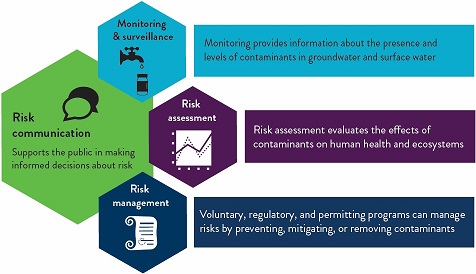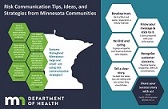Water Toolkit
Communication Types
- Everyday Communications
- Well-Known Issue Communications
- Emerging Issue Communications
- Crisis Communications
Communication Tools
Related Sites
Environmental Health Division
Drinking Water Risk Communication Toolkit
About Risk Communication
Risk communication is a science-based approach to communicating effectively to inform people about potential hazards to their person, property, or community.
Risk communication is about informing people of both bad and good potential outcomes. In the world of drinking water, potential risks and customer and community interests often overlap. From public health protection to environmental stewardship, members of the water sector should appreciate that their work ultimately comes down to understanding and minimizing risks.
Risk communication is a key strategy in the overall approach to address risks from contaminants in drinking water.

Risk managers - anyone who identifies, evaluates, and prioritizes risks - use risk communication to:
- Help community members understand the processes of assessing and managing risk.
- Use science to help community members understand risks and likely hazards.
- Help community members participate in making decisions about how risk should be managed.
Risk communication should be a two-way conversation. An agency or organization informs community members, and community members inform the agency or organization. When communicating about risk, always consider the context of the communication and the perceptions and values of the affected community.
 Nuggets from Minnesota Public Water System Professionals (PDF)
Nuggets from Minnesota Public Water System Professionals (PDF)
Why should we engage in risk communication?
- A contaminant issue or event, even one that doesn’t impact your community, creates public concern.
- Customers who are better informed by their water system are less critical of the system, even in the event of a problem.
- Relationships with partners and stakeholders are critical to an effective response to an emergency, but cannot be built during an emergency.
- Customers and other stakeholders will be more likely to accept guidance and more likely to work in partnership with a utility if they feel well-informed and included.
- Customers and other stakeholders will be more likely to accept guidance and more likely to work in partnership with a utility if they feel well-informed and included.
How you communicate is key
- Show empathy and caring for people who are concerned about contaminant exposures.
- Competence and expertise allow us to provide information and communications.
- Honesty and openness about what we know and what we do not know is key.
- Dedication and commitment keeps us engaged over time.
Great risk communication occurs when:
- The participants are informed,
- The process is fair, and
- Participants are free and able to solve whatever communication difficulties arise.
System staff have multiple roles when communicating with customers
- Service provider with duties to consumers and ratepayers based on legal and regulatory responsibilities.
- Expert on its own operations, technology, and the science of water treatment.
- Communicator on water monitoring activities, water quality, and health impacts with a stake in the outcome (changed perceptions or behaviors).
Focus on people! People think about risk in different ways
- Use clear communications - simplify your language and presentation not your content.
- Have a defined goal for communications.
- Whenever possible, use concrete examples and information that can be put into perspective.
- Communicate Early, Often, Fully, and Consistently.
- Remember that perception is reality.
- Know your audience – listen and respond to specific concerns.
- Use many forms and methods of communication to meet your audience where they are.
- Uncertainty is reality and uncertainty is different for everyday, issue and crisis communication.
Build trust over time with your community
- Have the right people - experts or system staff - delivering messages.
- When communicating with people, stay connected until all their questions are answered no matter how you are connected – through phone calls, public meetings, or other types of communication.
What are the roles for drinking water risk communication?
Minnesota Department of Health:
- The MDH mission is to protect, maintain, and improve the health of all Minnesotans. This includes partnering with drinking water systems to provide safe drinking water.
- MDH works to be as transparent as possible in the sharing and dissemination of information related to safe drinking water.
- MDH works with systems when there are communication challenges or system issues.
Public water systems:
- Provide drinking water services to customers while meeting legal and regulatory responsibilities.
- Communicate about these services, including monitoring activities, water quality and quantity, and health concerns.
- Maintain primary responsibility for communicating with customers and stakeholders. Partner with others when needed.
References
Mercer, Kenneth L. 2017 On Water & Works: Risk Communication. Journal AWWA.
Adapted from Talking to Your Customers About Chronic Contaminants in Drinking Water: A Best Practices Guide; US EPA. 2007.
Covello V. 1992. Risk communication, trust, and credibility. Health and Environmental Digest 6(1):1-4 (April) and Covello V. 1993. Risk communication, trust, and credibility. Journal of Occupational Medicine 35:18-19 (January).
US EPA Risk Communication Overview – Updated September 2016.
Consumer Perceptions and Attitudes Toward EDCs and PPCPs in Drinking Water. Water Research Foundation. 2013.
Adapted from Risk Communication Strategy and Tools: Guidelines for Communicating About Drinking Water Contaminants; Water Research Foundation, 2010.
Sandman, Peter, November 1987, Risk Communication: Facing Public Outrage, EPA Journal from the U.S. EPA.